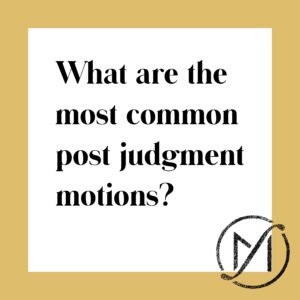What are the Most Common Post Judgment Motions After a Connecticut Divorce?

Many people wonder “What are the most common post-judgment motions?”
When the court finalized your divorce, it issued a divorce decree. That divorce decree is a final, enforceable court order. But sometimes, some of that order doesn’t work for you and your family. In other cases, one spouse doesn’t follow the order. Sometimes there are Post Judgment issues with property division, child support, alimony, or the parenting plan.
Read on to learn more.
Motion to Modify
A Motion to Modify seeks to change elements of a divorce decree, such as the amount set for child support or alimony. You may need a modification if, for example, you lose a job, get a new job, or experience a significant life change. A Motion to Modify may also be used to adjust the terms of a parenting plan or custody agreement so that they more accurately reflect your child’s needs as they grow. However, this motion does not apply to property division.
Read: What Is a Motion to Modify?
Motion for Contempt
When your former spouse (or another party) refuses to follow orders entered by the court, a Motion for Contempt may be used to address the situation. A Motion for Contempt is a civil law matter, which makes it slightly different from “criminal” contempt of court. However, certain penalties may still apply.
Read: What Is a Motion for Contempt?
Motion to Open
In some situations, evidence or facts might come to light only after the divorce has been finalized. When this happens, an appeal or a motion to modify might not be enough to make the change that is essential to your life or to the well-being of your children. In that case, a Motion to Open may be used to request the court to work through key questions raised by the new information.
Read: What is a Motion to Open a Judgment?
Motion to Compel
A Motion to Compel is a request to the court to require someone else to take a certain action. After a divorce judgment, it is most often used to require a party to that judgment to follow the court’s orders, although a Motion to Compel may be used for other purposes.
Motion to Set Aside
When a party is not satisfied with the end result of a divorce, he or she may file a Motion to Set Aside. This motion asks the court to overturn, or set aside, a final ruling in a case.
If you need insight into how to handle your Connecticut divorce Post Judgment, schedule a private consultation about your strategic options.
Next Steps
Knowing which Post Judgment motions to file in what circumstances requires a depth of knowledge and experience about Connecticut family law and with the Connecticut courts.
Depending on your circumstances, filing motions isn’t always a necessary or even preferable first course of action. If you prefer to reach an agreement rather than litigate, mediation and collaborative law are options to consider. In those cases, we submit the agreement you reach to the court so that it becomes an enforceable court order.
There are other creative solutions that may meet your needs and help you move forward without issues. Freed Marcroft’s family law attorneys can explain the ins and outs and put together a legal strategy for you, rooted in your goals.
Schedule your Goals & Planning Conference today, or contact us here.








